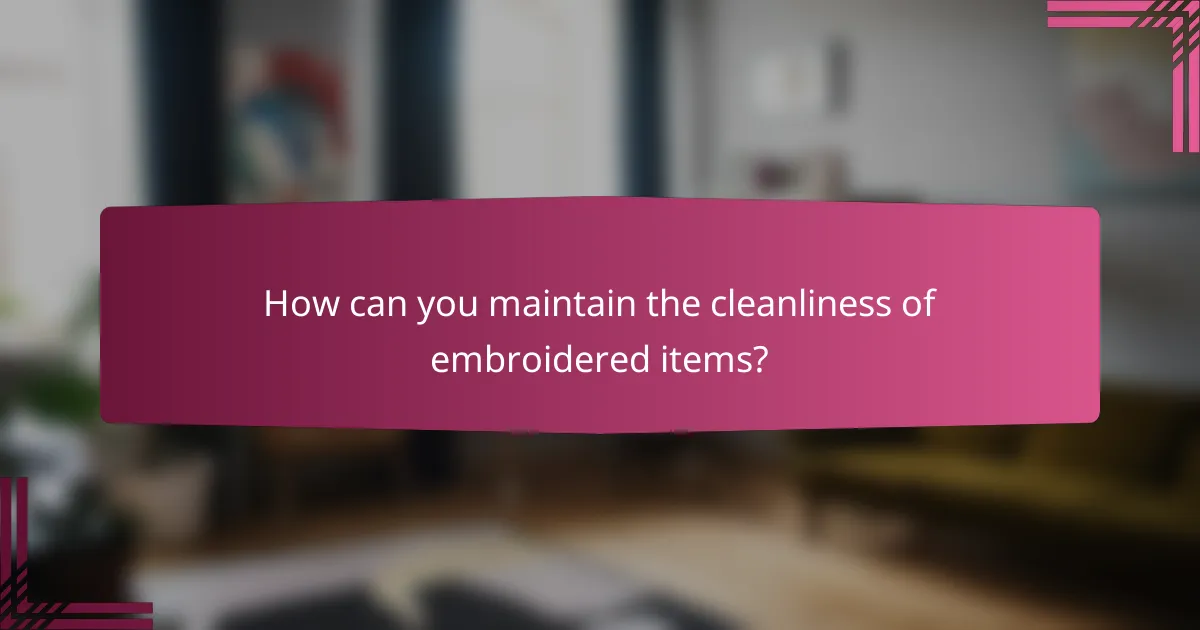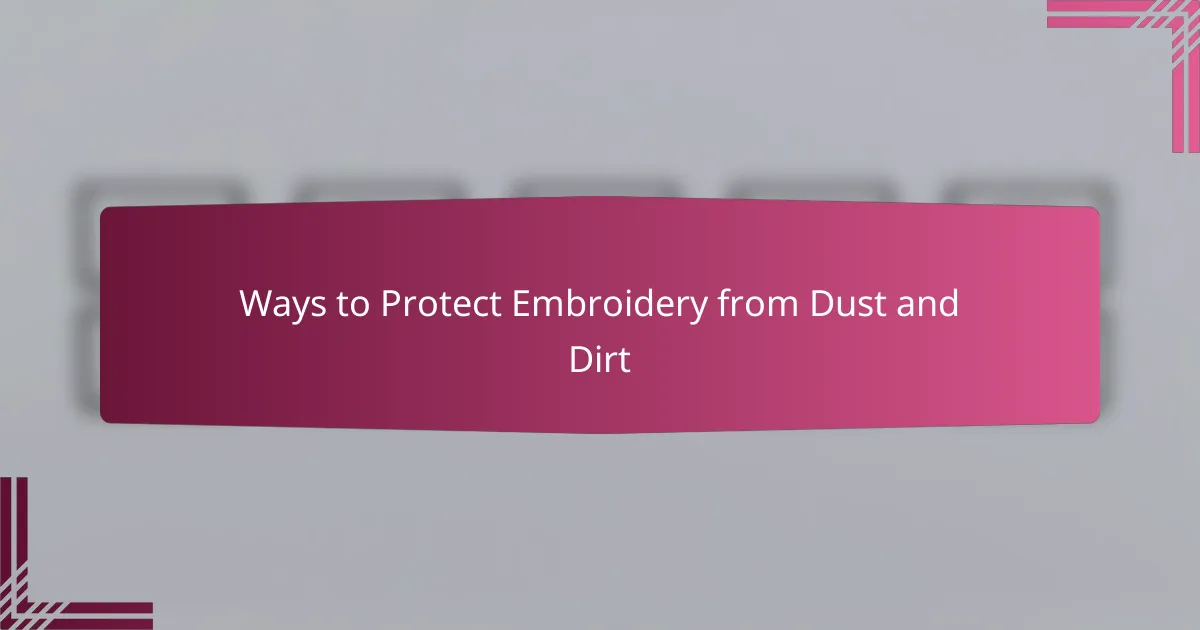
What are Effective Ways to Protect Embroidery from Dust and Dirt?
To protect embroidery from dust and dirt, use protective covers. These covers can be made of breathable fabric or plastic. They shield the embroidery from airborne particles. Regular cleaning of the display area is also essential. Dusting surfaces reduces the accumulation of dirt. Store embroidered items in airtight containers when not in use. This prevents exposure to dust over time. Additionally, avoid placing embroidery in direct sunlight. Sunlight can fade colors and attract dust. Lastly, consider using a vacuum cleaner with a soft brush attachment for delicate pieces. This method removes dirt without damaging the embroidery.
How can dust and dirt affect the quality of embroidery?
Dust and dirt can significantly degrade the quality of embroidery. They can cause discoloration and staining on the fabric. When dust settles on embroidery, it can lead to a dull appearance. Dirt can also get trapped in the stitches, affecting the design’s clarity. Additionally, dust and dirt may cause the threads to fray or break over time. This can compromise the overall durability of the embroidery. Regular cleaning and protective measures are essential to maintain embroidery quality. Studies show that keeping embroidery clean enhances its longevity and visual appeal.
What specific damages can dust and dirt cause to embroidered items?
Dust and dirt can cause discoloration, deterioration, and abrasion to embroidered items. The accumulation of dust can lead to staining, which may be difficult to remove. Dirt particles can settle into the fabric, weakening the fibers over time. Additionally, abrasive particles can fray threads, compromising the integrity of the embroidery. In some cases, dust can attract moisture, leading to mold growth. Regular cleaning can prevent these damages and maintain the quality of embroidered items.
Why is it important to protect embroidery from environmental elements?
Protecting embroidery from environmental elements is crucial to maintain its quality and longevity. Exposure to moisture can lead to mold and mildew growth, damaging the fibers. Sunlight can cause fading and degradation of colors over time. Dust and dirt can accumulate, making the embroidery look dull and dirty. Additionally, pollutants in the air can cause discoloration and deterioration of the fabric. Proper protection ensures that the intricate designs remain intact and vibrant. This preservation is essential for both aesthetic appeal and the durability of the embroidery.
What are the common methods for protecting embroidery?
Common methods for protecting embroidery include using protective covers, storing items properly, and applying fabric protectants. Protective covers, such as dust bags or cases, prevent dust accumulation. Proper storage in a cool, dry place minimizes exposure to dirt and moisture. Fabric protectants, like sprays, create a barrier against stains. These methods are widely recommended by textile care experts.
How do storage solutions contribute to protecting embroidery?
Storage solutions protect embroidery by providing a controlled environment that minimizes exposure to dust and dirt. Proper storage methods, such as using acid-free tissue paper and breathable fabric bags, help prevent contamination. Additionally, storing embroidery in a cool, dry place reduces the risk of moisture damage. These practices also protect against physical wear and tear, maintaining the integrity of the embroidery. Studies indicate that proper storage can extend the lifespan of textiles significantly. For example, textiles stored in optimal conditions can last for decades without significant degradation.
What types of protective covers are available for embroidery?
There are several types of protective covers available for embroidery. Common options include dust covers, storage bags, and protective sheets. Dust covers are typically made from breathable fabric. They shield embroidery from dust and dirt while allowing air circulation. Storage bags often feature zippers and padded interiors. These bags provide a secure environment for embroidered items. Protective sheets are usually plastic or thin fabric. They can be placed over embroidery to prevent direct contact with contaminants. Each type of cover serves to maintain the quality and appearance of embroidered pieces.
What preventive measures can be taken to minimize dust and dirt exposure?
To minimize dust and dirt exposure, implement regular cleaning routines. Vacuum carpets and upholstery frequently to reduce dust accumulation. Use air purifiers with HEPA filters to capture airborne particles. Seal windows and doors to prevent outdoor dust from entering. Employ dust covers on embroidery projects when not in use. Wash fabrics regularly to remove settled dust. Maintain low humidity levels to deter dust mite proliferation. Finally, store embroidery materials in airtight containers to keep them clean.
How does regular cleaning help in protecting embroidery?
Regular cleaning helps protect embroidery by removing dust and dirt that can cause deterioration. Accumulated debris can lead to discoloration and fabric wear over time. Regular maintenance prevents the buildup of grime that may damage the threads. Cleaning also helps maintain the vibrancy of colors in the embroidery. Additionally, it reduces the risk of mold and mildew, which can harm both fabric and thread. Studies show that proper care can extend the lifespan of embroidered items significantly. Overall, consistent cleaning is essential for preserving the quality and appearance of embroidery.
What role does humidity control play in preserving embroidery?
Humidity control plays a crucial role in preserving embroidery. High humidity can lead to mold growth and fabric deterioration. Conversely, low humidity may cause threads to become brittle and break. Maintaining a stable humidity level between 40% and 60% is ideal for fabric longevity. This range helps prevent moisture-related damage while keeping the fibers flexible. Research indicates that proper humidity levels can extend the lifespan of textiles significantly. For instance, the Textile Conservation Research Centre highlights that controlled environments reduce deterioration rates in embroidered fabrics.

How can you maintain the cleanliness of embroidered items?
To maintain the cleanliness of embroidered items, regularly dust them with a soft cloth. This prevents dirt accumulation on the fabric. For deeper cleaning, gently hand wash the items in cold water with mild detergent. Avoid using bleach or harsh chemicals, as they can damage the embroidery. Rinse thoroughly to remove all soap residues. Lay the items flat to dry, avoiding direct sunlight to prevent fading. If necessary, iron the items on a low setting, placing a cloth between the iron and the embroidery. Regular maintenance helps preserve the quality and appearance of embroidered items.
What cleaning techniques are best for embroidered fabrics?
Hand washing is the best cleaning technique for embroidered fabrics. Use cold water and a mild detergent. Gently agitate the fabric to avoid damaging the embroidery. Rinse thoroughly to remove all detergent residues. Air drying is recommended to prevent shrinkage or distortion. Avoid wringing or twisting the fabric, as this can harm the embroidery. For stubborn stains, spot cleaning with a soft cloth is effective. Always test any cleaning method on a small, inconspicuous area first.
How do you safely wash embroidered items without damage?
To safely wash embroidered items without damage, hand wash them in cold water. Use a gentle detergent that is free of bleach. Submerge the item and gently agitate the water. Avoid scrubbing or wringing the fabric. Rinse thoroughly in cold water to remove all detergent. Lay the item flat on a clean towel to dry. Do not hang the item, as this can distort its shape. Protect the embroidery by placing a clean cloth over it while drying. These methods help preserve the integrity of the embroidery.
What are the best practices for spot cleaning embroidery?
The best practices for spot cleaning embroidery involve using gentle techniques to avoid damage. Start by testing any cleaning solution on a hidden area. Use a soft cloth or sponge to apply the solution lightly. Blot the stained area instead of rubbing it. Rinse the cloth or sponge with clean water to remove any soap residue. Allow the embroidery to air dry completely. Avoid using harsh chemicals or bleach, as they can degrade the fabric and threads. Regular maintenance can prevent the buildup of dirt and stains on embroidery.
What tools and products can enhance protection for embroidery?
Protective tools and products for embroidery include fabric covers, storage boxes, and cleaning sprays. Fabric covers shield embroidered items from dust and dirt. Storage boxes provide a dust-free environment for storing completed projects. Cleaning sprays help maintain the cleanliness of the fabric without damaging the embroidery. These products are essential for preserving the quality of embroidery over time.
Which cleaning products are safe for embroidered fabrics?
Mild detergent and water are safe for embroidered fabrics. Use a gentle, pH-neutral detergent to avoid damage. Additional options include specialized fabric cleaners designed for delicate materials. Test any cleaner on a small, inconspicuous area first. Avoid bleach and harsh chemicals, as they can cause fading and fabric degradation. Gentle hand washing is preferable over machine washing. Always air dry embroidered items to maintain their integrity. Following these guidelines helps preserve the quality of the embroidery.
How can protective sprays or treatments help in maintaining embroidery?
Protective sprays or treatments help maintain embroidery by creating a barrier against dust and dirt. These sprays often contain water-repellent and stain-resistant properties. This barrier prevents particles from settling on the fabric. Additionally, protective treatments can enhance the longevity of colors and threads. They reduce the risk of fading and fraying due to environmental exposure. Many sprays are designed to be safe for various fabrics. Using these treatments can significantly decrease the frequency of cleaning. Regular application ensures that the embroidery remains vibrant and intact.

What are some practical tips for long-term embroidery care?
To ensure long-term care for embroidery, proper cleaning and storage are essential. Gently hand wash embroidered items in cold water with mild detergent. Avoid bleach, as it can damage the threads. After washing, lay the embroidery flat to dry, preventing distortion. Store embroidered pieces in a cool, dry place away from direct sunlight. Use acid-free tissue paper to prevent creasing during storage. Regularly dust the embroidery with a soft brush to keep it clean. If displaying, frame the embroidery under glass for protection from dust and dirt. These practices help maintain the quality and appearance of the embroidery over time.
How can you create a dedicated space for storing embroidery?
To create a dedicated space for storing embroidery, designate a specific area in your home. This area should be clean, dry, and away from direct sunlight. Use storage containers that are breathable to prevent moisture buildup. Organize embroidery supplies in labeled bins or shelves for easy access. Keep the area free of dust by using covers or cloths. Regularly check the space for any signs of pests or damage. This organized approach helps maintain the quality of your embroidery.
What features should an ideal storage solution have for embroidered items?
An ideal storage solution for embroidered items should have protective features to prevent damage. It must provide dust and dirt resistance to keep the items clean. The storage should be moisture-proof to avoid mildew growth, which can ruin embroidery. Adequate ventilation is essential to prevent musty odors and maintain fabric integrity. Transparent compartments allow for easy visibility, enabling quick access without unnecessary handling. The solution should also be padded to protect delicate stitches from pressure and abrasion. A modular design can facilitate organization and customization based on the collection size. Lastly, lightweight materials enhance portability for easy relocation or transport.
How often should you check on stored embroidery for dust and dirt?
Check on stored embroidery for dust and dirt at least once every month. Regular inspections help maintain the condition of the embroidery. Dust and dirt can accumulate quickly, especially in storage environments. Monthly checks allow for timely cleaning and preservation. This practice is recommended by textile conservation experts. They emphasize that regular maintenance prevents damage and discoloration. Consistent monitoring ensures the longevity of the stored pieces.
What are the common mistakes to avoid in embroidery care?
Common mistakes to avoid in embroidery care include improper washing techniques. Using harsh detergents can damage the threads and fabric. Ignoring care labels leads to inappropriate cleaning methods. Failing to air dry can cause shrinkage and distortion. Storing embroidery in damp areas promotes mold and mildew growth. Not using protective covers exposes embroidery to dust and dirt. Overloading washing machines can lead to tangling and fraying. Neglecting regular maintenance can result in fading and wear.
How can improper handling damage embroidered pieces?
Improper handling can damage embroidered pieces by causing fraying, distortion, and color fading. Fraying occurs when threads are pulled or snagged during handling. Distortion happens when embroidered items are creased or folded improperly. Color fading can result from exposure to moisture or direct sunlight. These damages can compromise the overall appearance and integrity of the embroidery. Proper care and handling techniques are essential to maintain the quality of embroidered pieces.
What should you avoid when cleaning or storing embroidery?
Avoid using harsh chemicals when cleaning or storing embroidery. These substances can damage the fabric and threads. Do not expose embroidery to direct sunlight. Prolonged sunlight can cause fading and deterioration. Refrain from using excessive water during washing. This can lead to warping and loss of shape. Avoid folding embroidery without protection. This can create creases and permanent marks. Do not store embroidery in damp areas. Moisture can promote mold and mildew growth. Lastly, avoid using abrasive materials for cleaning. Such materials can scratch and ruin delicate surfaces.
What are the best practices for protecting embroidery from dust and dirt?
To protect embroidery from dust and dirt, use a protective cover. A dust cover prevents particles from settling on the fabric. Store embroidered items in a clean, dry place. Avoid exposure to direct sunlight, which can fade colors. Regularly clean the storage area to minimize dust accumulation. Use acid-free tissue paper to wrap delicate pieces. This helps maintain their shape and prevents dirt contact. For frequently used items, consider using display cases. Display cases can shield embroidery while allowing visibility.
Embroidery is a delicate art form that requires protection from dust and dirt to maintain its quality and appearance. This article outlines effective strategies for safeguarding embroidered items, including the use of protective covers, proper storage solutions, and regular cleaning techniques. It highlights the negative impacts of dust and dirt on embroidery, such as discoloration and deterioration, and emphasizes the importance of humidity control and preventive measures. Additionally, it provides practical tips for long-term care and common mistakes to avoid, ensuring the longevity of embroidered pieces.
